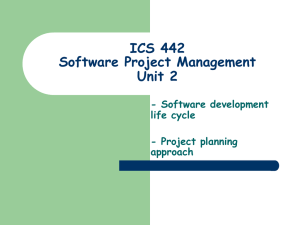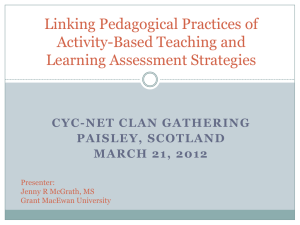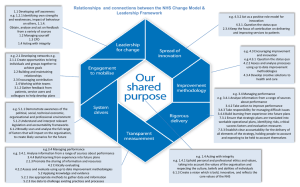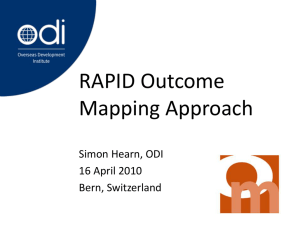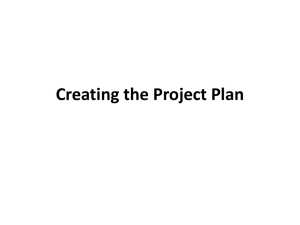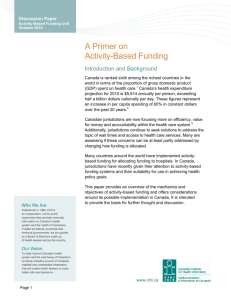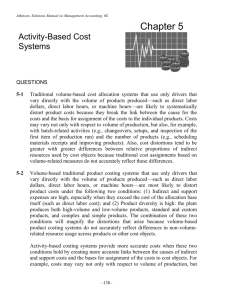Software Project Management
advertisement
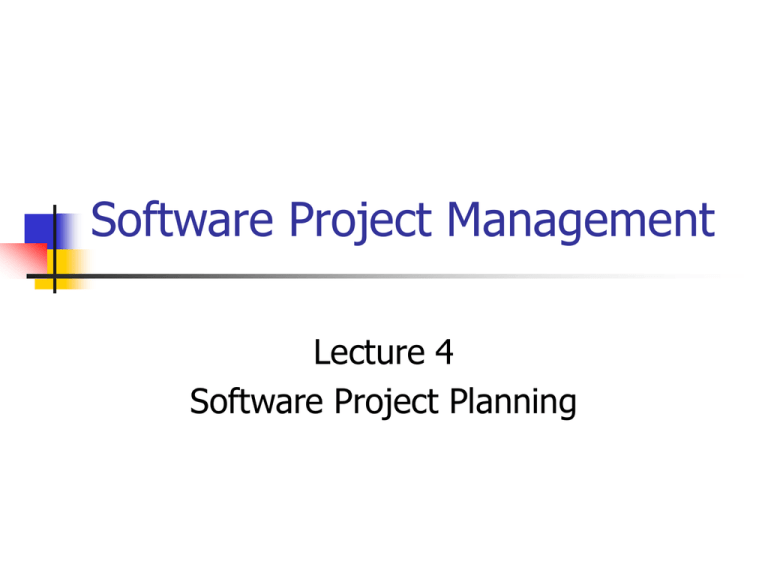
Software Project Management Lecture 4 Software Project Planning Overview Step Wise project planning framework Preparation of a software project plan Planning and scheduling the activities in software project management Various approaches towards activity plan Various scheduling techniques such as sequencing and CPM Software Project Management 2 Step Wise – An Overview 0 Select project 1 Identify project scope and objectives 2 Identify project infrastructure 3 Analyse project characteristics to next slide Software Project Management 3 Step Wise – An Overview (cont’d) from previous slide Review Lower level detail from next slide Software Project Management 4 Identify the products and activities 5 Estimate efforts for activity For each activity 6 identify activity risks to next slide 4 Step Wise – An Overview (cont’d) to previous slides from previous slide 10 Lower level planning 7 Allocate resources 9 Execute plan 8 Review/ publicize plan Software Project Management 5 Step Wise – An Overview (cont’d) Step 0: Select project Step 1: Identify project objectives Step 2: Identify project Step 3: Analyze project Step 4: Identify project activities Software Project Management scope and infrastructure characteristics products and 6 Step Wise - An Overview (cont’d) Step 5: Estimate effort for each activity Step 6: Identify activity risks Step 7: Allocate resources Step 8: Review/publicize plan Step 9: Execute plan Step 10: Execute lower levels of planning Software Project Management 7 Step 1: Identify Project Scope and Objectives Step 1.1 Identify objectives and practical measures of the effectiveness in meeting those objectives Step 1.2 Establish a project authority To ensure the unity of purpose among all persons concerned Software Project Management 8 Step 1: Identify Project Scope Objectives (cont’d) Step 1.3 Identify all stakeholders in the project and their interests Step 1.4 Modify objectives in the light of stakeholder analysis Step 1.5 Establish methods of communication between all parties Software Project Management 9 Step 2: Identify Project Infrastructure Step 2.1 Identify relationship between the project and strategic planning To determine the order of related projects (in the organization) being carried out To establish a framework within which the system fits To ensure the hardware and software standards are followed Software Project Management 10 Step 2: Identify Project Infrastructure (cont’d) Step 2.2 Identify installation standards and procedures more appropriate name: “Identify standards and procedures related to the software project” Step 2.3 Identify project team organization Software Project Management 11 Step 3: Analyse Project Characteristics Step 3.1 Distinguish the project as either objective-driven or product-driven Step 3.2 Analyse other project characteristics (including quality-based ones) Step 3.3 Identify high level project risks Step 3.4 Take into account user requirements concerning implementation Software Project Management 12 Step 3: Analyse Project Characteristics (cont’d) Step 3.5 Select general lifecycle approach in the light of the above Step 3.6 Review overall resource estimates Up to this stage, the major risks of the project are identified the overall approach of the project is decided So, it is a good place to re-estimate the required effort and other resources for the project Software Project Management 13 Step 4: Identify Project Products and Activities Step 4.1 Identify and describe project products Step 4.2 Document generic product flows Identify all the products related to the project Account for the required activities To document the relative order of the products Step 4.3 Recognize product instances Software Project Management 14 Step 4: Identify Project Products and Activities(cont’d) Step 4.4 Produce an ideal activity network Activity network shows the tasks that have to be carried out as well as their sequence of execution for the creation of a product from another Step 4.5 Modify the ideal to take into account need for stages and checkpoints To check compatibility of products of previous activities Software Project Management 15 Step 5: Estimate Effort for Each Activity Step 5.1 Carry out bottom-up estimates need to estimate staff effort, time for each activity, and other resources Step 5.2 Revise plan to create controllable activities need to break a task into a series of manageable sub-tasks Software Project Management 16 Step 6: Identify Activity Risks Step 6.1 Identify and quantify the risks of each activity Step 6.2 Plan risk reduction and contingency measures where appropriate Step 6.3 Adjust overall plans and estimates to take account of risks Software Project Management 17 Step 7: Allocate Resources (Staffing) Step 7.1 Identify and allocate resources type of staff needed for each activity staff availabilities are identified staff are provisionally allocated to task Step 7.2 Revise plans and estimates to take into account resource constraints staffing constraints staffing issues Software Project Management 18 Step 8: Review/publicize Plan Step 8.1 Review quality aspects of the project plan To ensure each activity is completed with a quality product Each activity should have ‘exit requirements’. This ensures the quality of the product on each activity. Software Project Management 19 Step 8: Review/publicize Plan (cont’d) Step 8.2 Document plans and obtain agreement all parties understand and agree to the commitments in the plan Software Project Management 20 Aside – When to plan Planning is an on-going process of refinement Planning at different stages of the project has different emphases and purposes Software Project Management 21 Project Vs Activity A project is composed of a number of related activities A project may start when at least one of its activities is ready to start A project will be completed when all of its activities have been completed Software Project Management 22 Project Vs Activity (cont’d) An activity must have a clear start and a clear stop An activity should have a duration that can be forecasted Some activities may require that other activities are completed before they can begin Software Project Management 23 Activity Planning A project plan is a schedule of activities indicating the start and stop for each activity Also provide the project and resource schedules The start and stop of each activity should be visible and easy to measure Each activity should have some ‘deliverables’ for ease of monitoring Software Project Management 24 Activity Planning (cont’d) During planning, managers consider: Resource availability Resource allocation Staff responsibility Project Monitoring Cash flow forecasting Re-planning of the project towards the predefined goal Software Project Management 25 Other Objectives of Activity Planning Feasibility assessment Resource allocation Detailed costing Motivation Co-ordination Software Project Management 26 Different Levels of Plans Project Schedule: a plan that shows 1. the dates when each activity should start and stop 2. when and how much of the resources will be required Activity Plan: a plan that describes how each activity will be undertaken Software Project Management 27 Project Schedule in 4 Stages Ideal Activity Plan An activity plan without any constraints Risk consideration for each activity Resource consideration for whole project Schedule production and publication Software Project Management 28 Various Approaches Towards Identifying Activity Activity-based approach Product-based approach Hybrid approach Software Project Management 29 Activity-based Approach Use Work Breakdown Structure (WBS) to generate a task list WBS involves identifying the main tasks break each main task down into subtasks The subtasks can further be broken down into lower level tasks. Software Project Management 30 Activity-based Approach (cont’d) Work Breakdown Structure (an extract) Software project Requirements Analysis System Design Data Design Software Project Management Coding Testing Process Design 31 Activity-based Approach (cont’d) Advantages More likely to obtain a task catalogue that is complete and is composed of nonoverlapping tasks WBS represents a structure that can be refined as the project proceeds The structure already suggests the dependencies among the activities Software Project Management 32 Activity-based Approach (cont’d) Disadvantage Very likely to miss some activities if an unstructured activity list is used Software Project Management 33 Product-based Approach Product Breakdown Structure (PBS) To show how a system can be broken down into different products for development Product Flow Diagram (PFD) To indicate, for each product, which products are required as ‘inputs’ Software Project Management 34 Product-based Approach (cont’d) Advantages Less likely to miss a product unexpectedly from a PBS Software Project Management 35 Product-based Approach – An example A Product Breakdown Structure (an extract) Inventory Control Inventory Databases Item Addition Item Database Vendor Database Item Deletion Item Modification Software Project Management Item Processing Item Purchasing Item Sales Management Reporting Item Reporting Sales Reporting Invoicing Sales Order subsystem Processing 36 Hybrid Approach A mix of the activity-based approach and the product-based approach More commonly used approach The WBS consists of a list of the products of the project; and a list of activities for each product Software Project Management 37 Hybrid Approach (cont’d) Software Project System Installation Software component User manual User Training Analyse requirements Review requirements Analyse requirements Design course Detailed design Outline design Design manual Write materials Integrate system Detailed design Document manual Print course materials Test system Code software Capture screens Training Deliver system Test software Print Manual Software Project Management 38 Hybrid Approach (cont’d) IBM in its MITP methodology suggests 5 levels Level Level etc) Level Level Level 1: Project 2: Deliverables (software, manuals 3: Components 4: Work-packages 5: Tasks (individual responsibility) Software Project Management 39 Planning and Scheduling the Activities Once we have a project plan (or, project schedule), we need to schedule the activities in a project taking into account the resource constraints Software Project Management 40 Scheduling Techniques Simple sequencing Suitable for small projects Critical Path Method (CPM) Suitable for large software projects The most commonly used “networking” technique Software Project Management 41 Simple sequencing A simple sequencing of the tasks and the responsible personnel taken into account of the resources Easily presented in a simple bar chart see figure 6.6 in Hughes book Suitable for allocating individuals to particular tasks at an early stage Software Project Management 42 Critical Path Method (CPM) Primary objectives: Planning the project so that it can be completed as quickly as possible Identifying those activities where their delays is likely to affect the overall project completion date Developed by Du Pont Chemical Company and published in 1958 Software Project Management 43 Critical Path Method (cont’d) Capture the activities and their interrelationships using a graph Lines are used to represent the activities Nodes are used to represent the start and stop of activities Software Project Management 44 Critical Path Method (cont’d) Adding time dimension The forward pass calculate the earliest start dates of the activities To calculate the project completion date The backward pass calculate the latest start dates for activities identify the critical path from the graph Software Project Management 45 Critical Path Method (cont’d) Identifying critical path and critical event Critical event: an event that has zero slack Critical path: a path joining those critical events Software Project Management 46 Example to construct a CPM Id. Activity Name Duration (weeks) Precedents A Hardware selection 7 B Software design 4 C Hardware Installation 6 A D Coding 4 B E Data Preparation 5 B F User Documentation 9 G User Training 5 E,F H System Installation 3 C,D Software Project Management 47 Example to construct a CPM (cont’d) Event Number 3 Earliest start date 1 7 Latest start date 6 Slack Software Project Management 48 Example to construct a CPM (cont’d) 2 7 0 A=7 1 0 0 7 B=4 3 4 0 6 C=6 4 D=4 13 13 0 2 H=3 6 16 16 0 E=5 F=9 5 9 G=5 11 2 Software Project Management 49 Activity Float Time allowed for an activity to delay 3 different types: Total float (without affecting the completion of the project) = latest start date – earliest start date Free float (without affecting the next activity) = earliest start date of next activity – latest end date of previous activity Interfering float (= total float - free float) Software Project Management 50 Significance of critical path During planning stage Shortening the critical path will reduce the overall project duration During management stage Pay more attention to those activities which fall in the critical path Software Project Management 51 References Hughes, B., and Cotterell, M. (1999) Software Project Management, 2nd edition, McGraw-Hill. Pfleeger, S.L. (1998) Software Engineering: Theory and Practice, Prentice Hall. Software Project Management 52


